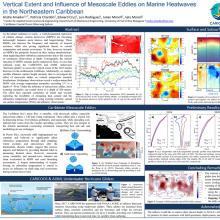Vertical Extent and Influence of Mesoscale Eddies on Marine Heatwaves in the Northeastern Caribbean
Andre
Amador
University of Puerto Rico Mayaguez, Caribbean Coastal and Ocean Observing System
Poster
As the planet continues to warm, a well-documented expression of climate change, marine heatwaves (MHWs) are becoming increasingly frequent, more intense, and longer-lasting. These MHWs increase the frequency and intensity of tropical cyclones, while also posing significant threats to coastal communities and marine ecosystems. To date, however, research on MHWs has primarily focused on their surface manifestations, often neglecting their subsurface characteristics due to the scarcity of continuous observations at depth. Consequently, the vertical structure of MHWs remains poorly understood. In this study, we use data collected using CARICOOS and AOML underwater “hurricane gliders” to assess the vertical extent of the 2023-2024 marine heatwave in the northeastern Caribbean. Additionally, we employ satellite altimeter surface height anomaly data to investigate the effect of mesoscale eddies on vertical temperature and salinity anomaly distributions, as well as their influence on the mixed layer and thermocline depths. Preliminary observations reveal a surface-intensified MHW with average temperature anomalies exceeding 2°C to a depth of about 50 m. Under the influence of anticyclonic eddies, these warming anomalies can extend down to a depth of 500 meters. The potential impacts of MHWs on coastal ecosystems and mesophotic reefs are explored.
The effort here reported constitutes an initial step towards exploring the feasibility of estimating heat content and the subsurface temperature gradient using existing remotely sensed SST and altimetry observations.
The effort here reported constitutes an initial step towards exploring the feasibility of estimating heat content and the subsurface temperature gradient using existing remotely sensed SST and altimetry observations.

Poster file
amador-andre-poster.pdf
(2.65 MB)
